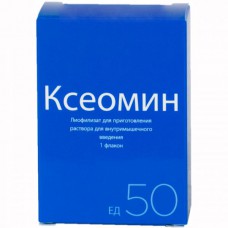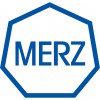Expiration date: 09/2026
Release form
Lyophilisate for preparation of solution for intramuscular injection
Composition
1 vial contains botulinum toxin type A 50 or 100 IU
Pharmacological action
Kseomin acts selectively on peripheral cholinergic nerve endings inhibits release of acetylcholine. Introduction in cholinergic nerve terminals occurs in three stages: binding of the molecule with the external components of the membrane, internalization of the toxin by endocytosis and translocation endopeptidase domain of the toxin from the endosome to cytosol. In the cytosol endopeptidazy domain molecules of the toxin selectively cleaves SNAP-25, an important protein component of the mechanism that controls membrane movement of Exo-vesicles, stopping, thus, the secretion of acetylcholine. The final effect is relaxation of the injected muscles.
The effect of the drug begins within four to seven days after injection. The effect of each procedure typically lasts three to four months, although it can last significantly longer or less.
Testimony
Blepharospasm, idiopathic cervical dystonia (spastic torticollis) of predominantly rotational form, spasticity arm after stroke, hyperkinetic folds (wrinkles) of the face.
Contraindications
The drug is contraindicated to people allergic to the drug components, in disorders of neuromuscular transmission (miastenia gravis syndrome of Lambert-Eaton, caution is prescribed for amyotrophic lateral sclerosis, and neurological diseases caused by degeneration of motor neurons and other diseases with disorders of neuromuscular transmission). The drug is not administered at an elevated temperature and acute infectious or non-infectious diseases.
The drug is contraindicated in pregnancy and lactation.
The drug is not administered to children and adolescents up to 18 years.
Method of application and doses
/M. the Drug can enter only doctors with special training and experience in the treatment with botulinum toxin and equipment for electromyography. The dosage and number of injections into the muscle doctor sets for each patient individually.
Blepharospasm: after dissolution Kseomin injected with a sterile needle 27-30 G.
The recommended initial dose — 1, 25-2, 5 ED (0, 05-0, 1 ml) at each injection site, the drug is injected in the medial and lateral part of the eye orbicular muscle(m. orbicularis oculi) of the upper eyelid and in the lateral part of the eye orbicular muscle of the lower eyelid.
If the vision is disturbed due to spasms in the forehead, the lateral sections of the circular muscle of the eye and upper face area, the area may be made to the injection. The effect of the drug begins, on average, within 4 days after injection. The effect of each treatment lasts usually 3-4 months, although it can last significantly longer or less.
If the effect of the initial dose was insufficient (duration
Spastic torticollis: in the treatment of spasmodic torticollis dosage should be adjusted to each patient individually, depending on the position of the head and neck, localization of pain, muscle volume (hypertrophy, atrophy), the body weight of the patient and its response to therapeutic treatments. In the practice of the treatment of the maximum dose in one procedure should not normally exceed 200 IU, but the possible dosage of up to 300 UNITS. In the same place, do not enter dose greater than 50 UNITS.
Therapy for spasmodic torticollis includes the injection in the sternocleidomastoid muscle, muscle, levator scapulae, scalenus, a muscle belt and/or the trapezius muscle.
You should not get injections into both sternocleidomastoid muscles, as this increases the risk of adverse effects (particularly dysphagia), which take place when bilateral injections in this muscle, or at doses exceeding 100 UNITS.
For injections into superficial muscles using needle rooms 25, 27 and 30 G, for deep muscle, a needle of 22 G.
In spastic torticollis to determine the involved muscles may be necessary electromyography. Carrying out injections in a few places allows the drug to evenly cover the areas of muscles affected by dystonia (especially when injected in large muscles). The optimal number of injection sites depends on the size of the muscle. The effect of the drug begins, on average, within 7 days after the injection. The effect of each treatment lasts approximately 3-4 months, but can last much longer or smaller. The interval between treatments should be at least 10 weeks.
Side effects
Adverse reactions are categorized by frequency of occurrence: very often (? 1/10), often (?1/100 to <, , 1="" 10="" 000="" 100="" br="">, Blepharospasm:
Frequent: ptosis (6, 1 %), dry eyes (2, 0 %).
Infrequent: paresthesia, conjunctivitis, dry mouth, skin rash, headache, muscle weakness.
In addition, when using a similar product containing botulinum toxin type A, and used in clinical trials along with Xeomin were noted following side effects. They are possible when applying Kseomina.
Often: superficial keratitis, lagophthalmos, skin irritation, photophobia, lacrimation.
Uncommon: keratitis, ectropion, diplopia, dizziness, diffuse skin rash/dermatitis, entropion century, focal paralysis of the facial nerve, weakness of facial muscles, fatigue, visual disturbances, blurred vision.
Rare: local swelling of the skin century.
Very rare: acute angle-closure glaucoma, ulceration of the cornea.
Spastic torticollis:
Common: dysphagia (10 %), muscle weakness (1, 7 %), back pain (1, 3 %). Uncommon: inflammation or pressing sensation in the injection site, headache, asthenia, generalized sweating, tremor, hoarseness, colitis, vomiting, diarrhea, dry mouth, bone pain, myalgia, skin rashes, itching, peeling skin, pain in the eyes.
In addition, when using a similar product containing botulinum toxin type A, and used in clinical trials along with Xeomin were noted following side effects. They are possible when applying Kseomina.
Very frequent: pain at the injection site.
Often: dizziness, increased blood pressure, numbness at the injection site, General weakness, flu-like symptoms, General malaise, dry mouth, nausea, headache, rigidity of the muscles at the injection site, irritation at the injection site, rhinitis, infections of upper respiratory tract.
Uncommon: dyspnoea, diplopia, fever, ptosis, speech disorders.
The severity of dysphagia ranges from mild to severe, with the possibility of aspiration, and in rare cases it may need medical help. Dysphagia may persist for two to three weeks after injection, but recorded case of a duration of 3 months. Dysphagia develops in a dose-dependent, according to clinical studies, dysphagia is rare if the total dose does not exceed 200 units in a single procedure.
Spasticity arm after stroke:
Often: headache, sensitivity, sensation of heat.
In addition, when using a similar product containing botulinum toxin type A, and used in clinical trials along with Xeomin were noted following side effects. They are possible when applying Kseomina.
Frequent: hypertonia, ecchymosis, local pain, muscle weakness, irritation or hemorrhaging at the injection site.
Uncommon: depression, sleep disturbances, paresthesia, ataxia, amnesia, vertigo, orthostatic hypotension, nausea, dermatitis, pruritus, rash, arthralgia, bursitis, fatigue, pain, hypersensitivity at the injection site, anxiety, peripheral edema.
Some side effects may be associated with underlying disease.
Hyperkinetic folds (wrinkles) of the face:
Common adverse effects are observed the first week after treatment and are temporary. Adverse effects may be associated with the active substance and/or procedure of injection.
The expected pharmacological effect of botulinum toxin is localized muscle weakness. Ptosis of the eyelids can be caused by the technique of injection and is associated with the pharmacological action of the drug.
As with any injection, it may local pain, pain, itching, swelling and/or hematoma, also may develop transient, VASO-magalnyk reactions such as syncope, circulatory problems, nausea or tinnitus, associated with excitement prior to injection.
When using the drug have reported the following adverse reactions:
Frequent: pruritus, headache, disorders of muscle function at the site of injection, feeling of heaviness.
Uncommon: flu-like symptoms, a feeling of tension at the site of injection, bronchitis, nasopharyngitis, feeling "nodules in the skin", swelling of the eyelids, ptosis, blurred vision, raising eyebrows, nausea, muscle twitching and spasms, local weakness of the facial muscles.
In addition, compared to a drug containing the usual complex of botulinum toxin type A and applied in several clinical studies (collected data so far suggests equal activity of both drugs) is known for the development of the following undesirable effects may occur when using Kseomina.
Uncommon: infection, paresthesia, dizziness, blepharitis, eye pain, dry mouth, photosensitivity, dry skin.
Common side effects:
The following information is based on data on the effects of other drugs containing botulinum toxin type A.
Information about the severe negative effects that may be associated with lesions of the cardiovascular system such as arrhythmias and myocardial infarction, including fatal, is extremely rare. Were these deaths caused by the injection of botulinum toxin type A, or concomitant cardiovascular disease, is uncertain. It reported one case of anaphylactic shock after administration of the drug containing botulinum toxin type A.
Marked side effects such as poliforma exudative erythema, urticaria, psoriasiform rashes, itching, and allergic reactions, however, their dependence on the complex action of the drug, contains botulinum toxin type A has not been confirmed.
Sometimes after injection of botulinum toxin type A observed changes in the electrophysiological background of some distant muscles, this side effect is not related to muscle weakness or other electrophysiological abnormalities. Drug interactions
Muscle relaxants peripheral actions should be used with caution while carrying out antibiotic therapy with aminoglycosides or spectinomycin (may increase the action of the Kseomina). The effect of the drug can be reduced by the action of derivatives of 4-aminohinolina.
Overdose
High-dose Kseomina can lead to the development of pronounced muscular paralysis in areas distant from the injection site (in particular: weakness, ptosis, diplopia, slurred speech and swallowing, and paralysis of respiratory muscles, leading to aspiration pneumonia).
In overdose requiring hospitalization with General supportive measures. Paralysis of the respiratory muscles required intubation and artificial ventilation until the normalization of condition.



